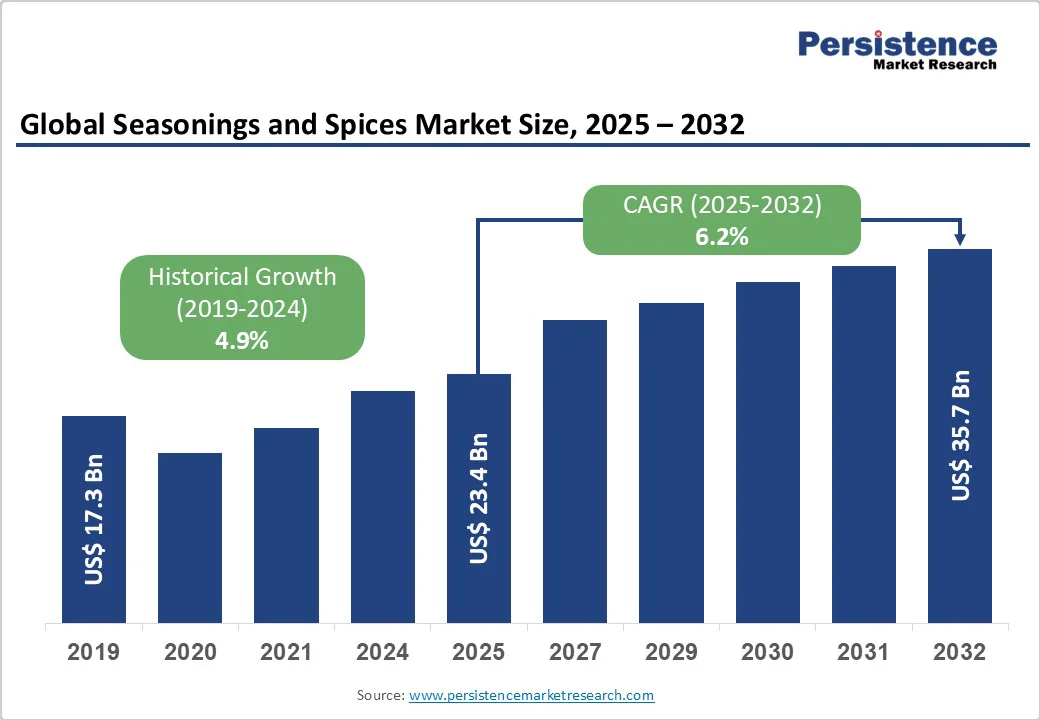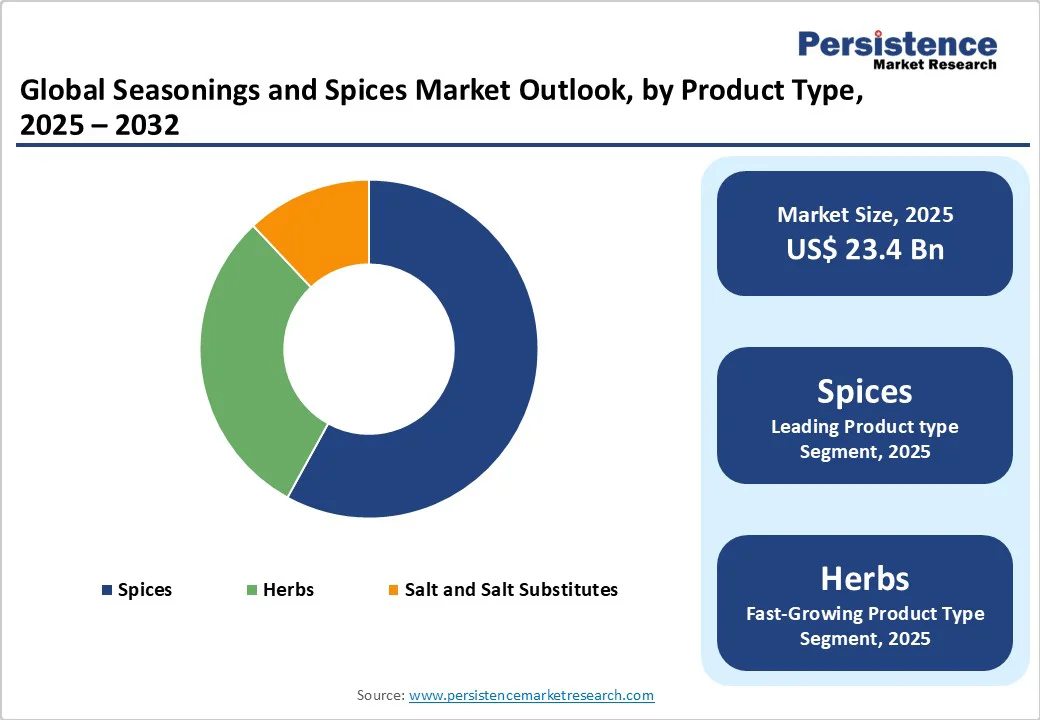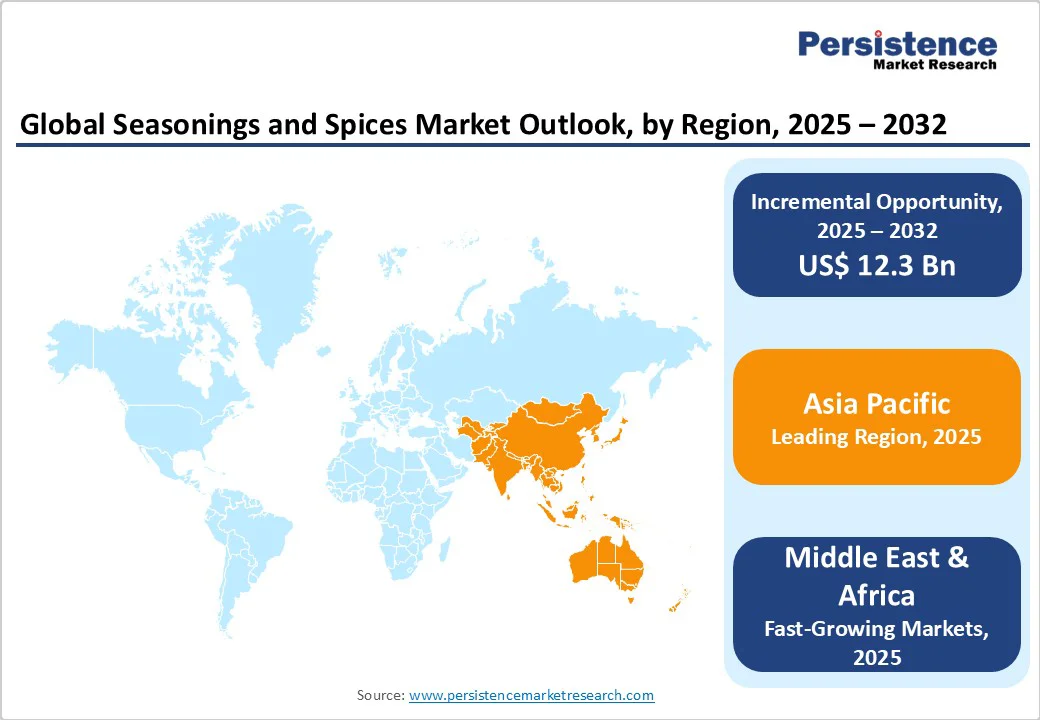ID: PMRREP3080| 192 Pages | 29 Oct 2025 | Format: PDF, Excel, PPT* | Food and Beverages

The global seasonings and spices market size is likely to value US$ 23.4 billion in 2025 and is projected to reach US$ 35.7 billion by 2032, growing at a CAGR of 6.2% during the forecast period from 2025 to 2032.
| Key Insights | Details |
|---|---|
| Global Seasonings and Spices Market Size (2025E) | US$ 23.4 Bn |
| Market Value Forecast (2032F) | US$ 35.7 Bn |
| Projected Growth (CAGR 2025 to 2032) | 6.2% |
| Historical Market Growth (CAGR 2019 to 2024) | 4.9% |

Culinary experiences are evolving rapidly, and the growth of restaurants, cafés, and quick-service restaurant (QSR) chains is driving consistent demand for premium and diverse spice and seasoning profiles. Chefs and foodservice operators are increasingly experimenting with exotic, regional, and artisanal flavors to create distinctive menus that appeal to adventurous and health-conscious consumers.
Specialty blends, smoked, roasted, or infused spices are being incorporated into dishes, beverages, and condiments to enhance taste complexity and authenticity. The expansion of international cuisine offerings, alongside rising consumer expectations for high-quality and flavorful meals, is encouraging suppliers to innovate and provide ready-to-use, clean-label, and organic spice solutions. This trend is strengthening the market for value-added seasonings while enabling brands to cater to both traditional and contemporary culinary demands globally.
Extreme climatic fluctuations are creating significant challenges for the global seasonings and spices market by causing inconsistent harvests of major spice crops. Unpredictable weather patterns, including droughts, excessive rainfall, heatwaves, and unseasonal storms, directly affect crop yield, quality, and chemical composition, leading to volatility in supply. Such variability increases procurement costs for manufacturers and disrupts production schedules for spice blends, packaged seasonings, and value-added products.
Smaller farmers and suppliers are particularly vulnerable, as crop failures can impact livelihoods and limit export potential. These supply inconsistencies also affect long-term contracts with foodservice providers and retail chains, forcing companies to maintain higher inventories or seek alternative sourcing. The resulting instability constrains market growth and challenges the scalability of innovation in premium and exotic spice offerings globally.
Forging direct partnerships with farmers presents a strategic opportunity for key players and startups in the global seasonings and spices market to ensure ethically sourced, sustainable, and fair-trade products. By collaborating closely with farmers and producers, companies can promote environmentally friendly cultivation practices, guarantee consistent quality, and support local communities with fair compensation. Such initiatives resonate with increasingly conscious consumers seeking transparency, traceability, and social responsibility in their food choices.
Brands can differentiate themselves by highlighting farm-to-table stories, organic certification, and traceable sourcing in packaging and marketing campaigns. Additionally, long-term collaborations enable supply stability, reduce dependency on intermediaries, and foster innovation in rare or specialty spices. Prioritizing ethical sourcing strengthens brand reputation, appeals to premium markets, and positions companies to capitalize on the growing demand for sustainable spice offerings globally.
Spices hold approximately 59% share as of 2025, making them the leading product type in the global seasonings and spices market due to their essential role in flavor enhancement, culinary versatility, and cultural significance.
High consumer demand for authentic, bold, and diverse flavor profiles across restaurants, home cooking, and processed foods drives consistent adoption. Herbs are gaining traction as consumers increasingly seek fresh, aromatic, and functional ingredients for health-conscious and gourmet recipes.
Salt and salt substitutes are expanding in low-sodium and heart-healthy formulations, catering to wellness-focused consumers. Together, these segments diversify the product portfolio, but spices remain dominant due to their foundational status in global cuisines, extensive applications, and ability to meet evolving taste and dietary preferences across regions.
Organic seasonings and spices are projected to achieve a healthy CAGR of 8% during the forecast period, driven by increasing consumer awareness of health, wellness, and sustainable food practices. Rising demand for chemical-free, pesticide-free, and non-GMO ingredients encourages both manufacturers and retailers to expand organic offerings in culinary, processed food, and ready-to-eat segments.
Organic certifications assure consumers of traceability, ethical sourcing, and environmentally responsible cultivation, strengthening brand trust and loyalty.
Specialty herbs, spice blends, and functional seasonings with organic labels are gaining popularity in home kitchens, restaurants, and QSRs, appealing to health-conscious and eco-conscious buyers. As clean-label preferences rise globally, organic seasonings and spices are poised for steady growth, capturing emerging opportunities in premium, sustainable, and wellness-oriented food markets.

Asia Pacific holds nearly 39% share driven by increasing culinary diversity, rising disposable incomes, and evolving consumer palates across the region. In China, there is a growing preference for bold, authentic flavors in ready-to-eat meals and restaurant offerings, fueling demand for both traditional and innovative spice blends.
India continues to witness strong adoption of regional and ethnic spices in home cooking, packaged foods, and foodservice channels, supported by expanding e-commerce platforms. Southeast Asia is experiencing increased demand for premium, sustainably sourced spices and herbs, as consumers embrace clean-label and organic products. The proliferation of modern retail formats, online grocery channels, and gourmet dining experiences is further accelerating the penetration and innovation of seasonings and spices across Asia Pacific.
Middle East & Africa Seasonings and Spices market is expected to grow at a leading CAGR driven by rising urbanization, expanding hospitality sectors, and increasing consumer interest in diverse and authentic flavors. In the UAE and Saudi Arabia, demand for premium spice blends and ready-to-use seasonings is rising, fueled by modern dining, gourmet cooking, and international cuisine adoption.
North African countries such as Morocco and Egypt show strong growth in traditional and ethnic spices, with a growing focus on organic and sustainably sourced products. The proliferation of supermarkets, hypermarkets, and online grocery platforms is enhancing accessibility, while rising awareness of health benefits associated with spices like turmeric, cumin, and cinnamon encourages incorporation into everyday cooking. Overall, the region is witnessing steady growth across retail, foodservice, and packaged product segments.

The global Seasonings and Spices market is highly fragmented, with numerous regional players and global corporations competing to capture consumer loyalty through innovation and quality. Leading companies are expanding product portfolios with premium spice blends, ready-to-use marinades, and ethnic seasoning mixes while emphasizing sustainable sourcing and clean-label claims.
Startups are introducing niche innovations, including exotic spice infusions, functional blends with health benefits, and customized culinary kits for home cooks. Marketing strategies leverage digital campaigns, influencer partnerships, and interactive recipe content to engage consumers and build brand recognition.
Collaborative efforts with chefs, foodservice chains, and e-commerce platforms are driving wider reach. The focus on convenience, authenticity, and flavor diversity ensures continuous product differentiation and reinforces competitiveness in this dynamic market.
The global seasonings and spices market is projected to be valued at US$ 23.4 Bn in 2025.
Rising expansion of restaurants, cafés, and QSR chains is driving consistent demand for premium and diverse spice and seasoning profiles, fueling growth in the global Seasonings and Spices market.
The global seasonings and spices market is poised to witness a CAGR of 6.2% between 2025 and 2032.
Collaborating with farmers to source spices ethically, while promoting sustainability and fair-trade practices, represents a significant market opportunity.
Major players in the Global Seasonings and Spices market include McCormick & Company, Inc., Ajinomoto Co., Inc, Olam Group, FUCHS GmbH & Co. KG, DS Group, MDH, Everest Spices and others.
| Report Attribute | Details |
|---|---|
| Historical Data/Actuals | 2019 - 2024 |
| Forecast Period | 2025 - 2032 |
| Market Analysis | Value: US$ Bn |
| Geographical Coverage |
|
| Segmental Coverage |
|
| Competitive Analysis |
|
| Report Highlights |
|
By Product Type
By Nature
By Form
By Distribution Channel
By Region
Delivery Timelines
For more information on this report and its delivery timelines please get in touch with our sales team.
About Author